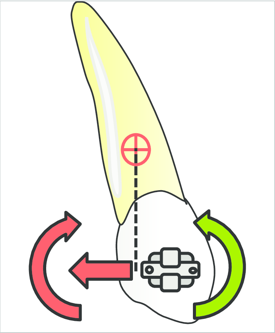ORTHODONTICS SIMPLIFIED
Principles of Biomechanics
- Orthodontic tooth movement results from the application of forces to teeth. The orthodontic appliances that are selected, inserted, and activated by the clinician produce these forces.
- The cells of the periodontium, which respond to the applied forces, their activity is solely dependent upon the stress and strain occurring in their environment, independent of the bracket design, wire used or other appliance related factors.
- The basis of orthodontic treatment lies in the clinical application of biomechanic concepts.
- Mechanics - is the discipline that describes the effect of forces on bodies.
- Biomechanics - refers to the science of mechanics in relation to biologic systems.
Mechanical concepts in Orthodontics
- Center of mass - All objects have a center of mass. This is the point through which an applied force must pass for a free object to move linearly without any rotation, i.e., the center of mass is an object’s “balance point.” (FREE OBJECT).

- A tooth within the periodontal system is restrained by the periodontium, it’s not a free body.
- Center of Resistance - The center of resistance is analogous (similar or comparable to) to the center of mass for restrained bodies and is the equivalent “balance point” for restrained bodies. (RESTRAINED OBJECT

- Single teeth, units of teeth, complete dental arches, and the jaws themselves each have center(s) of resistance.
- The center of resistance of a tooth is dependent on the root length and morphology, the number of roots, and the level of alveolar bone support.

- Analytic studies have determined that the center of resistance for single-rooted tooth with normal alveolar bone levels - about 1/4th to 1/3rd the distance from the cementoenamel junction (CEJ) to the root apex.
- The center of resistance of facial bones (i.e. the maxilla), entire teeth arches, or segments of teeth may also be estimated.
- Experimental and analytic studies report the center of resistance for a maxilla - slightly inferior to the orbitale for the maxilla, and distal to the lateral incisor roots for intrusive movements of maxillary anterior teeth.
FORCE
- Forces are actions (push or pull) applied to a tooth that result in orthodontic tooth movement.
- Force is equal to mass multiplied by acceleration (F = ma).
- Its units are Newtons or gram x (millimeters/second).
- Force is a Vector and has both magnitude and direction.

- The magnitude of the vector - size.
- Direction - vector’s line of action, sense, and point of origin (or point of application).
- Value of X axis = V cos
- Value of Y axis = V sin

- Resultant force = F1 + F2
MOMENT OF FORCE IN ORTHODONTICS
- In orthodontics, most of the forces are applied at the crown level through various appliances. So, the force applied is not in line of center of resistance of the tooth.
- And we have already seen, that the force acting through the center of resistance will produce a linear motion of the object. So, in this case, the force is acting away from the center of resistance. That means it will not produce only linear movement of the tooth but also some degree of rotation (tipping) will also be produced.
- This effect is caused by Moment of force - the moment of the force is the tendency for a force to produce rotation.

- The units of measurement of moments are in gram-millimeters (Newton- millimeters).
- The two variables of moment of force are the magnitude of the force and the distance- both can be manipulated by the dentist to achieve the desired amount of force in a desired direction.
MOMENT OF COUPLE
- Moment of a couple - Another method of achieving rotational movements.
- Couple - is two parallel forces of equal magnitude acting in opposite directions and separated by a distance (i.e. different lines of action).
- The magnitude of a couple is calculated by multiplying the magnitude of force(s) by the distance between them; the units are also in gram-millimeters.
- Couple results in pure rotational movement of the object regardless of the point of application of the forces.
TORQUE
- Torque is a common synonym for moment (both moments of forces and of couples).
- Torque is erroneously described in terms of degrees by many orthodontists.






